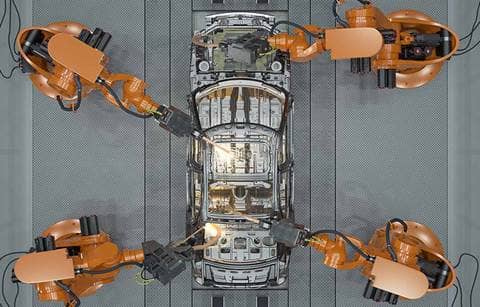The results are in, and more relevant than ever. The findings of the 20th annual North American Automotive OEM-Supplier Working Relations Index ® (WRI ®) Study are especially relevant and actionable in light of mobility trends like electrification and, most immediately, the COVID-19 pandemic.
Auto suppliers provide over two-thirds of the value of a vehicle, and strong customer-supplier relations, in which trust is a key factor, can determine overall OEM success. The 2020 WRI® Study, a proven toolset for measuring the degree of trust between parties, surveyed 840 suppliers and six OEMs. While trust is always important, situations such as the COVID-19 crisis emphasize just how critical it is to the supply chain to maximize flexibility to respond, optimize resilience, and better prepare for future challenges.
Overall findings
Overall, the 2020 Plante Moran WRI® Study shows an increased gap between the best and the worst working relationships among FCA, Ford, GM, Honda, Nissan, and Toyota and their suppliers. The spread in rank suggests that the effectiveness of supplier support for the industry restart will vary greatly.
New this year, the WRI® study includes an additional purchasing group, electric and hybrid-electric vehicles (EVs/HEVs). Our analysis shows that the auto industry needs to focus greater attention on EV component and advanced material purchasing to best commercialize supplier innovations and differentiate OEMs in the marketplace.
Top 10 insights
We’ve distilled the key findings from the 2020 WRI® study into 10 actionable insights.
1. Suppliers are always unique to the vehicle manufacturer.
Three OEM-supplier relations indices increased and three decreased for 2020, with Toyota, Ford, and FCA improving their numbers year over year. The data point to the fact that suppliers need to respond to diverse situations among their customer base, since each vehicle manufacturer is facing unique circumstances, challenges, and opportunities.
2. Primary drivers of WRI® results reflect specific and widely differing OEM situations.
Among the OEMs that saw improvements over last year, trust and concern for supplier margins helped reduce friction and improve alignment with OEM engineering. Among OEMs whose indices dropped, financial pressures, reduced engineering alignment, and lack of reward for high-performing suppliers were the primary key drivers.
3. Alignment between engineering and purchasing is improving.
The industry appears to be moving through the major product and architecture consolidation we’ve seen over the past couple of years. But, while product cycle plans may have solidified, COVID-19 may set off a new round of product churn, and we may see more consolidation or canceled programs. Good working relations help both OEMs and suppliers better manage the resulting volatility more effectively.
4. Suppliers can use WRI® data to create their commercial strategies.
WRI® findings help suppliers gain an objective, holistic view that extend beyond day-to-day interactions of OEM approaches to commercial relationships. This enables suppliers to assess those relationships — are they adversarial, transactional, or strategic and collaborative? Each requires different levels of trust, communications, and investment. Objective data enables suppliers to better align their strategies with their investment plans and better know their customer.
5. B2B trust is hard to earn and requires three main inputs.
Business trust doesn’t come easily, and it’s contextual. Supplier-OEM trust, required in legacy internal combustion engine (ICE) component procurement, for example, looks different from trust required to make new investments in electrification or other new technologies with uncertain volumes.
As survey data and additional analysis show, trust is a function of following through with promises made, realistic asks, and open sharing of information. These key elements bring greater flexibility during crises — COVID-19 as well as inevitable future disruptions — and help both OEM and supplier take on greater risk to support one other. The study finds that in fact suppliers provide greater support above and beyond contract requirements with OEMs that earn higher WRI® scores.
6. Commercializing new technology requires high-trust relationships.
The WRI® Supplier Benefit IndexTM, an important area of the study, shows that suppliers are more willing to invest in new technologies, share ideas for development, and provide other nonprice benefits to OEMs with which they have deeper, better working relationships. Vehicle manufacturers with the highest WRI® scores tend to have a broader base of suppliers willing to invest in innovation and new technology. This does and will continue to drive success with the EV and HEV transition and other CASE (connected, autonomous, shared, electric) mobility trends.
7. WRI® scores for EV and HEV purchasing groups rank among the strongest.
When WRI® data are analyzed by purchasing area, EVs and HEVs earn the highest WRI® scores of all purchasing groups. The strength of these relationships is a positive trend, since strong working relations are absolutely critical to bringing in new technology at cost, with high quality, and on time. Closer working relationships between engineering and purchasing on technologies under development likely contribute to these findings.
8. OEMs need to focus on fixed-investment risk and transaction disputes.
With the consolidation of nameplates, platforms, and assembly plants as well as the movement of sourcing among the United States, Canada, and Mexico, suppliers are more critical of OEMs’ willingness to equitably share the risk of sunk investment cost. Near-term transitions from trucks to passenger vehicles and from ICE to EVs and HEVs as well as sourcing under the U.S.-Mexico-Canada Agreement, show that OEMs will need to ensure forecasting is more accurate and processes are in place to deal with contingencies should investments not pay expected returns.
WRI® data also show that OEM actions related to resolving piece price and tooling cost disputes are improving. There is room for further improvement, but trendlines are moving in a positive direction.
9. Consistency in rewarding high-performing suppliers is eroding.
With so much industry and intracompany change over the past five years, it may not be surprising that the consistency with which vehicle manufacturers reward high-performing suppliers has declined. This is troubling since it’s a key measure of strong OEM-supplier working relations. Rewarding good performance — with future generation programs and supplier council positions, as examples — should be no different than how you recognize, reward, and encourage your own employees to go above and beyond their contractual obligations.
10. It’s not about absolute profit margin, it’s about the opportunity.
This is another insightful theme that remains true in the 2020 WRI® study, as in years past: It’s not all about the margin. Suppliers seek a return on their capital investments, and they’re willing to go the extra mile to support OEMs that support them. This finding is particularly noteworthy now, as the industry continues to grapple with the impacts of COVID-19. Global vehicle production forecasts for 2025 have fallen off by 10 to 20%. Reducing the friction of doing business by improving mutual trust and overall working relations will help all parties maximize resources and ROI.
Putting findings to work for increased trust and profitability
It’s not hard to see how the complex, global issues such as the recent health crisis and inevitable supply chain disruptions that threaten business continuity can strain relationships. By their nature, these challenges can’t be foreseen or written into a scope of work. So how do suppliers and OEMs alike translate WRI® study findings and key data points into strong commercial relationships that increase the degrees of freedom of companies and their supply chains to respond?
We’re often asked this question and, in response, we like to draw upon the concept of the flywheel from Jim Collins, author of “Good to Great.” Applying the concept to the WRI® study highlights how trust isn’t a one-time decision or action — there’s no sending the right memo and it’s done. Rather, it’s a series of actions that over time build momentum and move the needle (that is, the heavy flywheel, in keeping with the concept).
The WRI® study has shown that, among OEMs and suppliers, the actions that build trust over time include:
- Improving communications and engagement.
- Reducing barriers and hindrances.
- Aligning business functions and supportive financial processes.
- Implementing effective assistance programs.
- Providing profit opportunities for both parties.
With the WRI® toolset, companies can establish their customer-supplier relationship baseline and initiate or advance their journey to greater trust.
For a deeper dive on the WRI®, learn how suppliers and OEMs can leverage study results, or contact us to learn how we can apply the methodology and findings to your company’s specific customer strategies and supplier relations.
About the Working Relations Index® Study: The 2020 North American Automotive OEM-Tier 1 Supplier Working Relations Index® Study was developed by Dr. John Henke, of Planning Perspectives, Inc. Now in its 20th year, the 2020 study was led by Plante Moran and was conducted from mid-February to mid-April. Respondents are salespersons from Tier-1 suppliers serving the top three Detroit and top three Japanese automakers. The annual study tracks supplier perceptions of working relations with their automaker customers in which they rate them across the eight major purchasing areas broken down into 20 commodity areas. Respondents represented 841 salespersons from 503 Tier-1 suppliers, representing about 60% of the six OEMs’ annual buy. The sales personnel provided data on 2,752 buying situations (for example, supplying brake systems to FCA US, tires to Toyota, seats to GM). Demographically, the supplier-respondents represent 45 of the top 50 North American suppliers and 81 of the top 100 North American suppliers.
About Plante Moran: Recognized as a leader in automotive and mobility strategy, Plante Moran is among the nation’s largest accounting, tax, and consulting firms and provides a full line of services to organizations across many industry segments. In addition to automotive, Plante Moran has depth of expertise in manufacturing and distribution, private equity, Japanese-owned businesses, financial institutions, service, healthcare, public sector, and real estate and construction. Headquartered in Southfield, Mich., Plante Moran has a staff of more than 3,200 professionals throughout Colorado, Illinois, Michigan, and Ohio with international offices in China, India, Japan, and Mexico. Plante Moran has been recognized by several organizations, including Fortune magazine, as one of the country’s best places to work. For more information, visit plantemoran.com.





